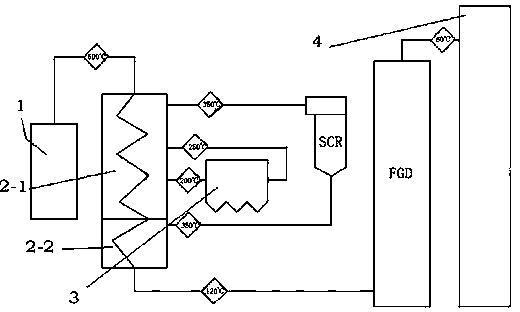Glass kiln flue gas de-dusting, denitrification and desulfurization integral treatment process
A glass kiln and flue gas technology, which is applied in the new process of desulfurization integrated treatment, denitrification, glass furnace flue gas dust removal, can solve the problem that the efficiency of high-temperature electric dust removal is difficult to achieve the design efficiency, and the design efficiency, investment and operation costs cannot be achieved. Large and other problems, to achieve the effects of small footprint, low heat loss, and reduced operating costs
- Summary
- Abstract
- Description
- Claims
- Application Information
AI Technical Summary
Problems solved by technology
Method used
Image
Examples
Embodiment Construction
[0019] see figure 1 Flow chart:
[0020] 1) Waste heat boiler (can be a heat exchanger):
[0021] The waste heat boiler 2-1, including the second group of waste heat boiler 2-2, has three inlets and three outlets, and the three inlets are respectively the inlets of the high-temperature flue gas 1 of the glass kiln (there will be a temperature of about 500°C for the intake air) 1. The entrance of the flue gas that meets the dust removal standard and the flue gas inlet that meets the denitrification standard; the three exits are respectively entering the high-temperature dust removal section, entering the denitration section and entering the desulfurization section. Through the reasonable design and transformation of waste heat boilers, each flue gas treatment section is guaranteed to be carried out under the most suitable temperature conditions, thereby ensuring the reliability of the system; waste heat boilers can be divided into two groups, the first group of waste heat boil...
PUM
 Login to View More
Login to View More Abstract
Description
Claims
Application Information
 Login to View More
Login to View More - R&D
- Intellectual Property
- Life Sciences
- Materials
- Tech Scout
- Unparalleled Data Quality
- Higher Quality Content
- 60% Fewer Hallucinations
Browse by: Latest US Patents, China's latest patents, Technical Efficacy Thesaurus, Application Domain, Technology Topic, Popular Technical Reports.
© 2025 PatSnap. All rights reserved.Legal|Privacy policy|Modern Slavery Act Transparency Statement|Sitemap|About US| Contact US: help@patsnap.com

